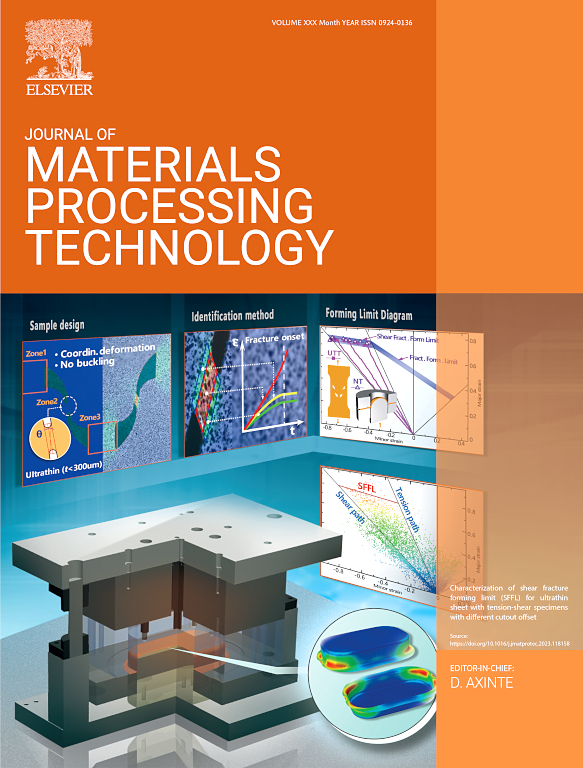小球头金刚石砂轮超精密磨削硬脆材料的材料去除机理
IF 7.5
2区 材料科学
Q1 ENGINEERING, INDUSTRIAL
Journal of Materials Processing Technology
Pub Date : 2025-07-11
DOI:10.1016/j.jmatprotec.2025.118977
引用次数: 0
摘要
小球端细粒金刚石砂轮具有优异的加工灵活性和材料去除能力,在复杂曲面零件的超精密磨削中具有显著的优势。减小磨粒尺寸被认为是实现硬脆材料塑性去除同时抑制亚表面损伤的有效策略。然而,小球头砂轮加工硬脆材料时的材料去除机理尚不清楚,从而限制了其在超精密加工中的广泛应用。本研究选择硬脆材料的代表熔融石英,研究磨料粒度对表面完整性和磨削特性的影响。结果表明:细粒砂轮虽然具有优良的表面质量,但在磨削过程中产生了明显的犁头效应,降低了材料去除效率,加速了砂轮磨损,增大了磨削力;通过单晶SPH刻划模拟和应力场分析,阐明了不同磨粒尺寸下熔融石英的亚表面损伤演化过程。通过TEM分析,揭示了小球端砂轮在塑性和脆性两种去除模式下的损伤机理。最后,对典型的小型复杂曲面部件半球形谐振器进行了磨削实验,验证了磨料粒度调制在实际加工中的可行性。本研究建立了小球端砂轮磨削硬脆材料的损伤机理框架,为小型复杂曲面零件的低损伤精密加工提供理论和工艺指导。本文章由计算机程序翻译,如有差异,请以英文原文为准。
Material removal mechanism in ultra-precision grinding of hard and brittle materials using small ball-end diamond grinding wheel
Small ball‐end fine-grained diamond grinding wheel offers notable advantages in the ultra-precision grinding of small complex curved-surface components, owing to their excellent machining flexibility and material removal capability. Reducing abrasive grain size is considered an effective strategy for achieving plastic-regime removal of hard and brittle materials while suppressing subsurface damage. However, the material removal mechanism during the machining of hard and brittle materials using small ball-end grinding wheels remains inadequately understood, thereby limiting their broader application in ultra-precision machining. In this study, fused silica, a representative hard and brittle material, was selected to investigate the influence of abrasive grain size on surface integrity and grinding characteristics. The results demonstrated that although the finer-grained grinding wheel produced excellent surface quality, it induced significant ploughing effects during grinding, which reduced material removal efficiency, accelerated grinding wheel wear, and increased grinding force. Furthermore, single-grain SPH scratching simulation and stress field analysis were conducted to clarify the subsurface damage evolution of fused silica under different abrasive grain sizes. Moreover, the damage mechanisms in both plastic-regime and brittle-regime removal modes when using small ball-end grinding wheels were revealed through TEM analysis. Finally, grinding experiments on typical small complex curved-surface components, hemispherical resonators, were performed to validate the feasibility of abrasive grain size modulation in practical machining. This study establishes a damage mechanism framework for grinding of hard and brittle materials using small ball-end grinding wheels, providing both theoretical and process guidance for low-damage precision machining of small complex curved-surface components.
求助全文
通过发布文献求助,成功后即可免费获取论文全文。
去求助
来源期刊

Journal of Materials Processing Technology
工程技术-材料科学:综合
CiteScore
12.60
自引率
4.80%
发文量
403
审稿时长
29 days
期刊介绍:
The Journal of Materials Processing Technology covers the processing techniques used in manufacturing components from metals and other materials. The journal aims to publish full research papers of original, significant and rigorous work and so to contribute to increased production efficiency and improved component performance.
Areas of interest to the journal include:
• Casting, forming and machining
• Additive processing and joining technologies
• The evolution of material properties under the specific conditions met in manufacturing processes
• Surface engineering when it relates specifically to a manufacturing process
• Design and behavior of equipment and tools.
 求助内容:
求助内容: 应助结果提醒方式:
应助结果提醒方式:


